Incorporating Renewable Energy Science in Regional Landscape Design: Results from a Competition in The Netherlands
Abstract
:1. Introduction
2. The Ninth Eo Wijers Regional Landscape Design Competition

“Alternative energy sources can reduce dependence on fossil fuels. Bio-, solar, geothermal and wind energy have potential. The national government wants to realize 400 MW extra wind energy capacity in Northeast Netherland. Also the regional authorities want to encourage reliable and affordable energy provision with low emissions of greenhouse gases. Therefore, make the most of the opportunities for renewable energy generation and distribution, inter alia by providing adequate spatial possibilities. Also saving energy, the careful use of subterranean resources for energy provision, the storage of CO2, green gas, natural gas and energy infrastructure are important. What do these mean for regional spatial development? The central notion in the ‘Grounds for Change’ philosophy is that our society must adjust to contemporary landscapes, which emerge through the use of, for example, wind power, and a more intensive use of subterranean resources. This process meets resistance in society and therefore demands careful selection and development of landscape sites and the involvement of the population.”
3. Theoretical Framework
3.1. Reductions in Energy Demand
3.2. Diversity of Supply
3.3. Reduction of Fossil Fuel Emissions
3.4. Consideration of the Energy System Components
4. Materials and Methods
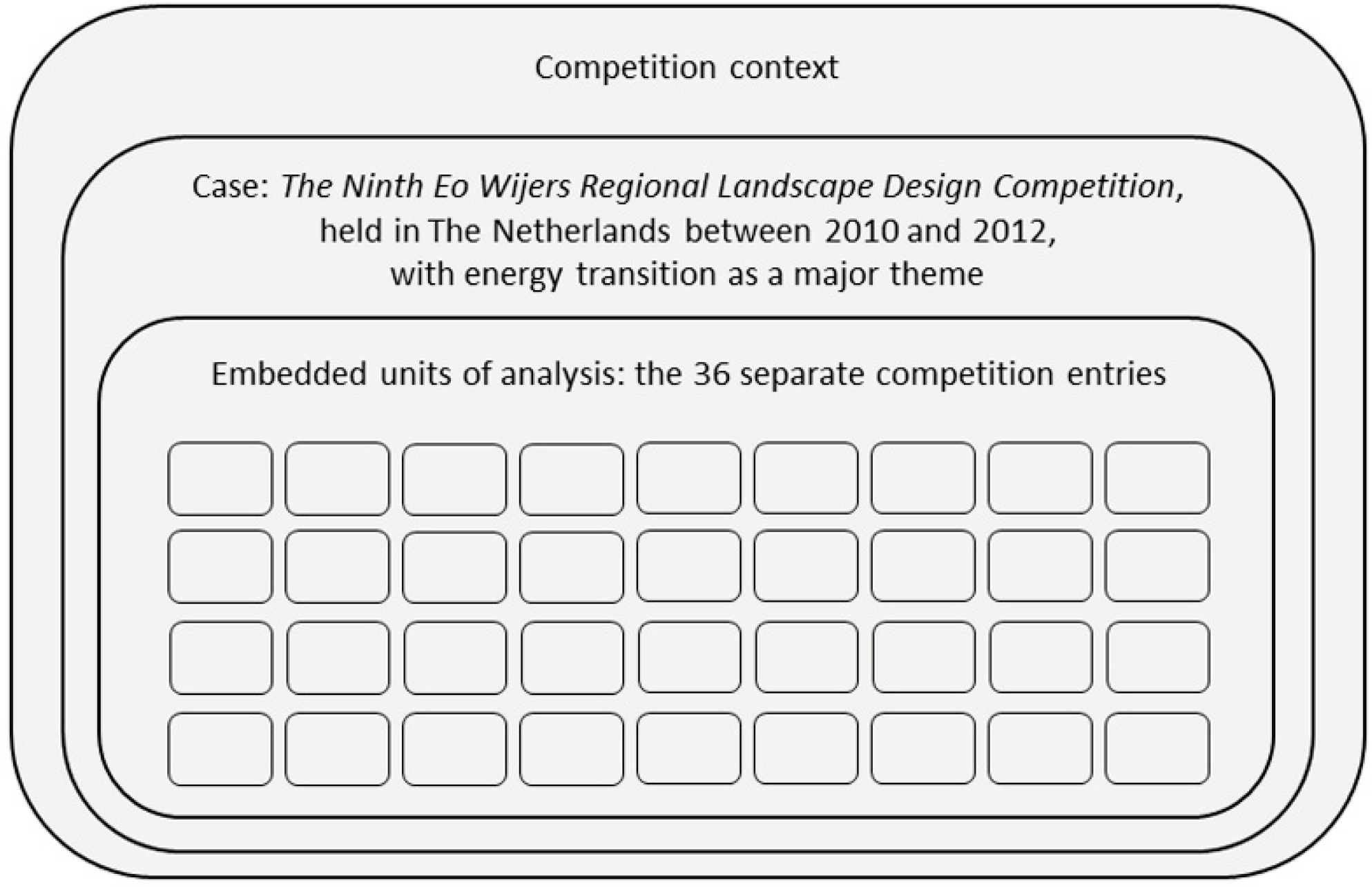
4.1. Content Analysis of the 36 Competition Entries
- (1)
- Catering for the regional energy demand using at least two options derived from electricity, heat, and (transport) fuels;
- (2)
- Making use of at least one renewable energy source and/or conversion technology;
- (3)
- Making use of more than one kind of renewable energy source and/or conversion technology and in this way acknowledging the need for a diversified energy mix.
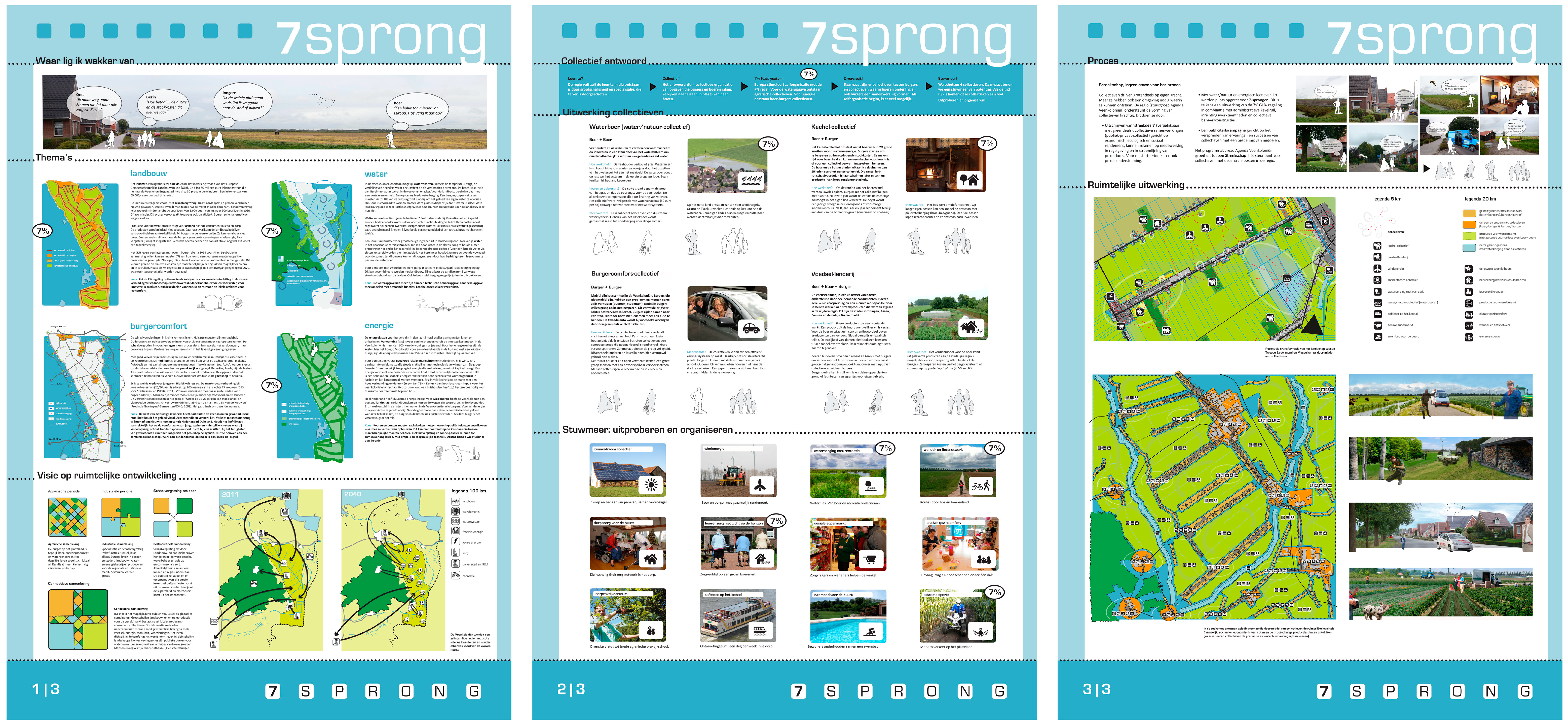
4.2. Study of the Competition Context and Triangulation of Data and Methods
4.3. Research Quality and Limitations
5. Results and Discussion
5.1. The Competition Entries
| Origin | Strategy | Dimension Present in the Entries | % of the Entries |
|---|---|---|---|
| Renewable energy science | Reductions in energy demand | Proposals for improving energy efficiency, e.g., by energy saving measures | 31% |
| Reference to goals for energy efficiency and/or renewable energy generation in specific, quantitative terms | 8% | ||
| Diversity of supply | Catering for the regional energy demand using at least two options derived from electricity, heat, and (transport) fuels | 78% | |
| Making use of at least one renewable energy source and/or conversion technology | 97% | ||
| Making use of more than one kind of renewable energy source and/or conversion technology and in this way acknowledging the need for a diversified energy mix | 86% | ||
| Calculations indicating the contribution of proposed energy-conscious interventions | 14% | ||
| Reduction of fossil fuel emissions | Proposals for the use of CCS (Carbon Capture and Storage) and/or alternative solutions for reducing fossil fuel emissions | 19% | |
| Consideration of the energy system components | Proposals for at least two of the following: energy generation, energy distribution, and energy storage | 58% | |
| Proposals for energy generation, energy distribution and energy storage that acknowledging the fact that energy-conscious interventions should be seen as components of a larger energy system | 25% | ||
| The competition brief | The nature of proposals | Process-oriented proposals for realizing energy-conscious designs and plans | 89% |
| Spatially explicit designs for locating, planning and/or designing energy-conscious interventions | 58% | ||
| Integration with other (competition) themes and interests | Combinations of energy-conscious interventions and other (competition) themes that show energy transition from an integrative landscape design perspective | 89% | |
| Extent to which entries document the motivations for energy-conscious interventions | 97% |
5.1.1. Reductions in Energy Demand
5.1.2. Diversity of Supply
| Renewable Energy Sources and Conversion Technologies | % of the Entries |
|---|---|
| Biomass (excluding biomass waste streams) | 75% |
| Wind energy: onshore wind turbines | 64% |
| Solar energy: photovoltaic cells | 50% |
| Biomass waste streams | 47% |
| Residual heat | 36% |
| Heat and cold storage | 19% |
| Solar energy: solar collectors | 17% |
| Geothermal energy: heat | 17% |
| Combined heat and power | 17% |
| Geothermal energy: electricity | 6% |
| Other | 36% |
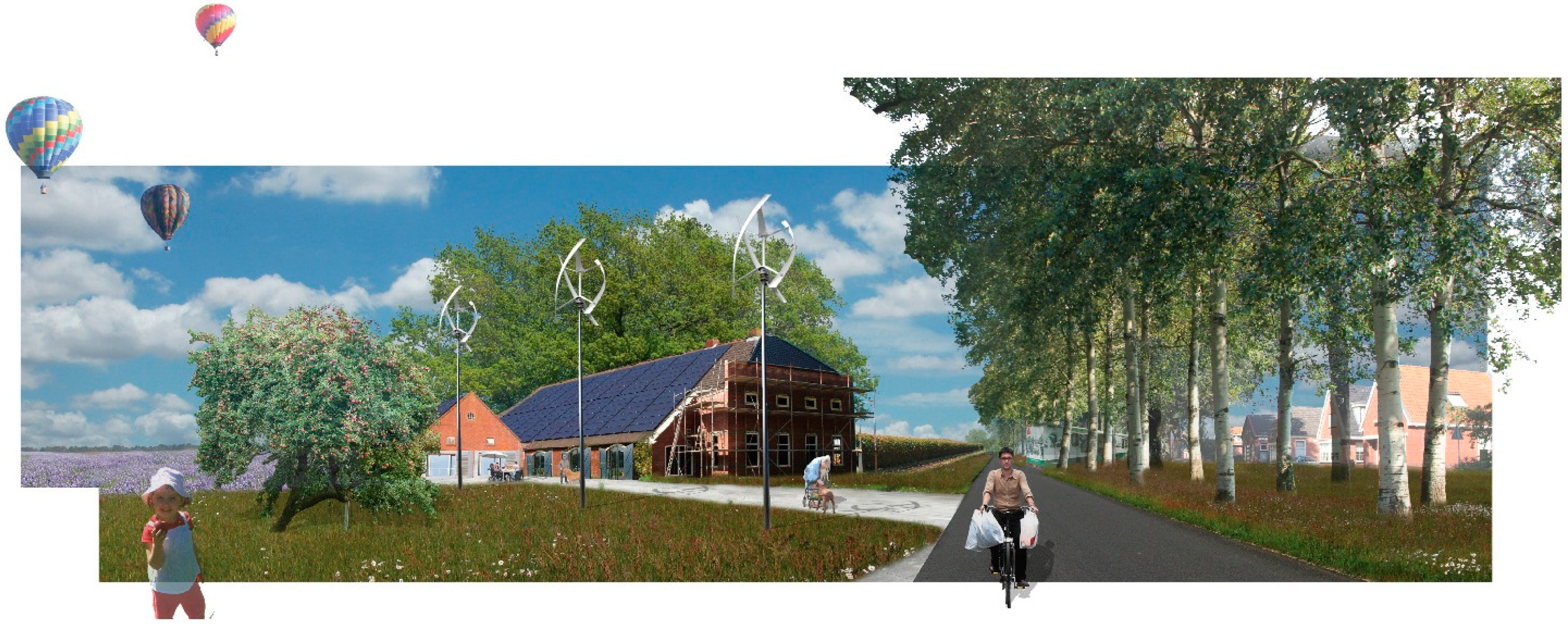
5.1.3. Reduction of Fossil-Fuel Emissions
5.1.4. Consideration of the Energy System Components
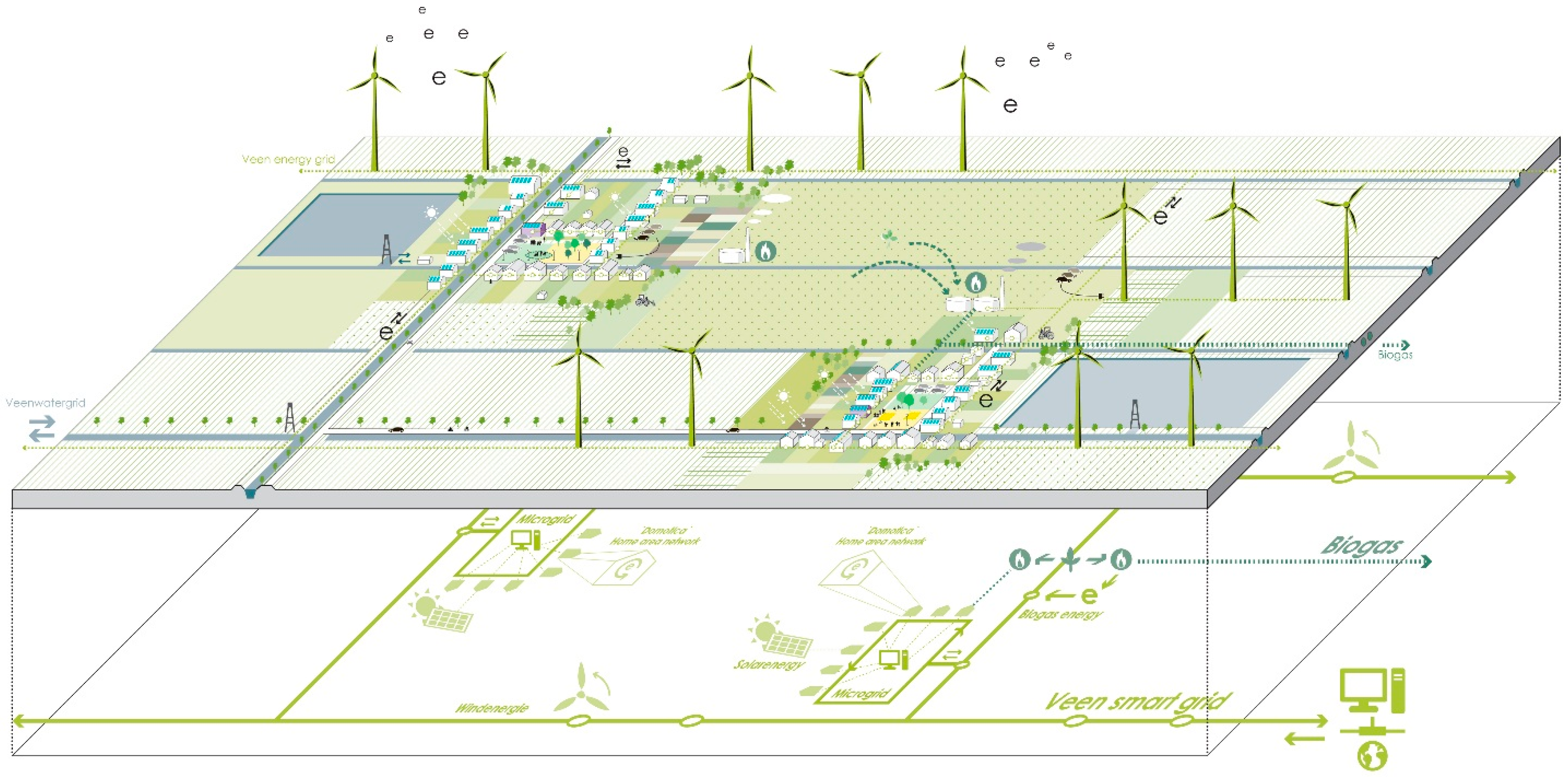
5.1.5. The Nature of Proposals: Spatially Explicit and/or Process-Oriented
5.1.6. Integration of Energy Transition Interventions with Other Competition Themes and Interests
| Combinations with Other Competition Themes and Land Uses | % of the Entries |
|---|---|
| Agriculture | 72% |
| Water | 44% |
| Nature | 22% |
| Habitation | 22% |
| Industry | 19% |
| Recreation | 17% |
| Amenities (shopping, nightlife etc.) | 11% |
| Education and Research | 8% |
| Welfare (healthcare, childcare etc.) | 8% |
| Infrastructure | 6% |
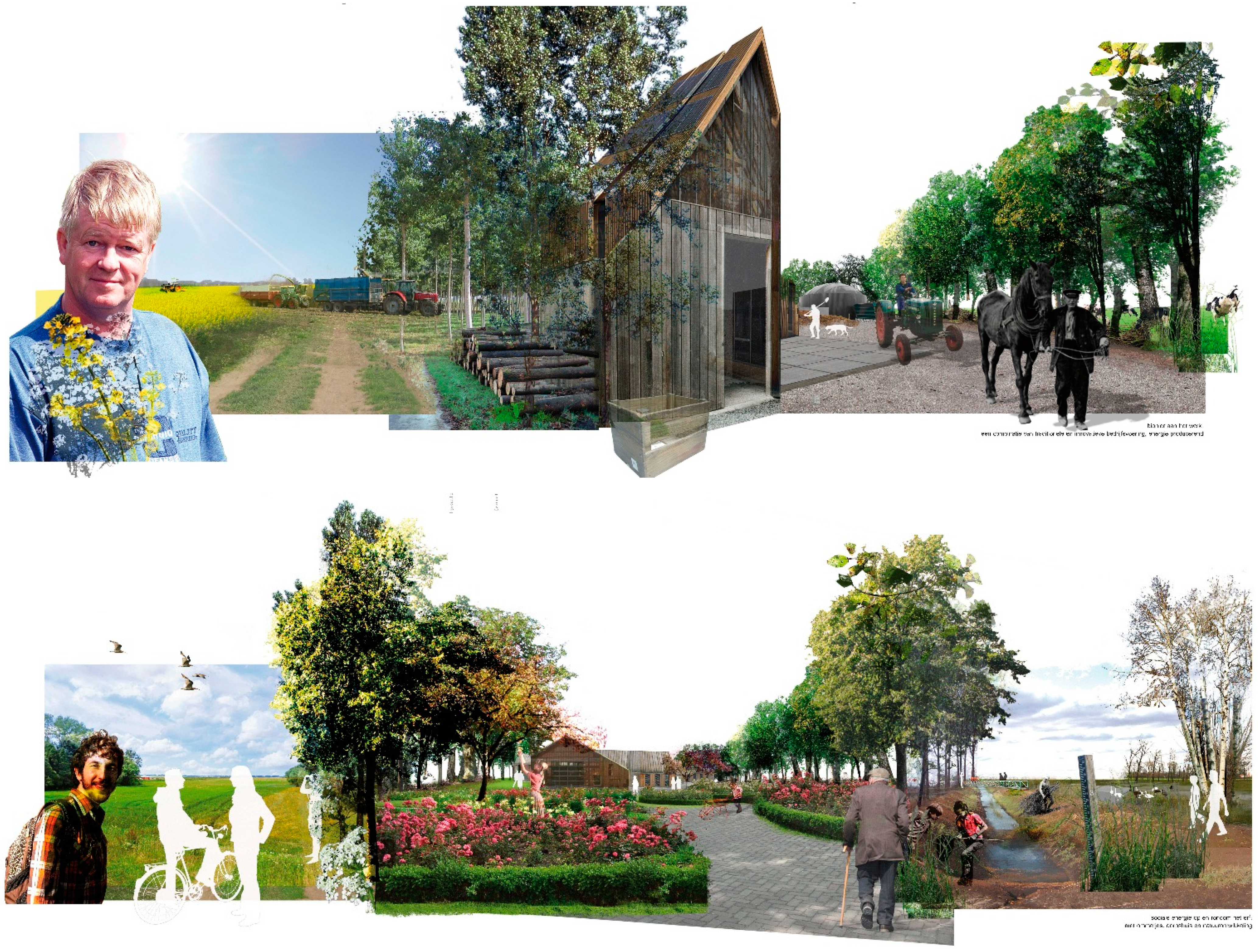
| Motivations and Interests | % of the Entries |
|---|---|
| Stimulating regional economy | 55% |
| Maintaining or improving landscape quality | 47% |
| Sustainability | 36% |
| Energy independence | 19% |
| Raising awareness about energy transition | 6% |
| Security of supply | 3% |
| Affordability of supply | 3% |
| Public acceptance of renewable energy technologies | 3% |
| Turning the region into a testing ground | 3% |
5.2. The Judging Process and Outcomes
5.3. Survey among the Competition Entrants
- The respondents were positive about the potential contribution landscape design could make to energy transition (38% responded “yes, to large extent”; 54% responded ‘yes, to some extent’; seven percent responded ‘no’ and one percent responded “I do not know”);
- More than half the respondents believed that energy transition provides an opportunity to enhance spatial quality in the Netherlands (22% fully agreed; 35% partly agreed, 25% did not agree or disagree, 10% partly disagreed, 3% percent fully disagreed and 5% percent did not know).
| Types of Information Sources | Counts | Different Documents |
|---|---|---|
| Report by engineering or design firm | 6 | 6 |
| Book aimed at a professional audience | 6 | 3 |
| Input by expert | 3 | 3 |
| Research report | 3 | 3 |
| Opinion article | 1 | 1 |
| Policy report | 1 | 1 |
| Report by NGO | 1 | 1 |
| Scientific literature | 1 | 1 |
| Symposia | 1 | 1 |
| Totals | 23 | 20 |
6. Conclusions
Acknowledgments
Author Contributions
Conflicts of Interest
References
- Sijmons, D.; Hugtenburg, J.; Feddes, F.; van Hoorn, A. Landscape and Energy, Designing Transition; NAi010 Publishers: Rotterdam, The Netherlands, 2014. [Google Scholar]
- Tester, J.W.; Drake, E.M.; Driscoll, M.J.; Golay, M.W.; Peters, W.A. Sustainable Energy: Choosing among Options; MIT Press: Cambridge, MA, USA; London, UK, 2005. [Google Scholar]
- Twidell, J.; Weir, A.D. Renewable Energy Resources, 2nd ed.; Taylor & Francis: Oxon, UK, 2006. [Google Scholar]
- Brundtland, G.H. Report of the World Commission on Environment and Development: “Our Common Future”; United Nations: New York, NY, USA, 1987. [Google Scholar]
- Leenaers, H.; Camarasa, M. De Bosatlas van de Energie; Noordhoff Uitgevers: Groningen, The Netherlands, 2012. [Google Scholar]
- Mulder, K. The technological landscape. In Landscape and Energy: Designing Transition; Sijmons, D., Hugtenburg, J., Feddes, F., van Hoorn, A., Eds.; NAi Publishers: Rotterdam, The Netherlands, 2014; pp. 368–380. [Google Scholar]
- Pasqualetti, M.J. Reading the changing energy landscape. In Sustainable Energy Landscapes. Designing, Planning and Development; Stremke, S., van den Dobbelsteen, A., Eds.; CRC Press (Taylor & Francis Group): Boca Raton, FL, USA, 2013; pp. 11–44. [Google Scholar]
- Ghosn, R. New Geographies 2: Landscapes of Energy; Harvard University Press: Cambridge, MA, USA, 2009. [Google Scholar]
- Bloemers, T.; Daniels, S.; Fairclough, G.; Pedroli, B.; Stiles, R. Landscape in a Changing World; ESF and COST: Strassbourg, France, 2010. [Google Scholar]
- Stremke, S.; van den Dobbelsteen, A. Sustainable Energy Landscapes; Designing, Planning and Development; CRC Press (Taylor & Francis Group): Boca Raton, FL, USA, 2013. [Google Scholar]
- Ivančić, A. Energyscapes; Editorial Gustavo Gili: Barcelona, Spain, 2010. [Google Scholar]
- Radzi, A. 100% Renewable champions: International case studies. In 100% Renewable. Energy Autonomy in Action; Droege, P., Ed.; Routledge: New York, NY, USA, 2009; pp. 93–166. [Google Scholar]
- Van Hoorn, A.; Matthijsen, J. De Ruimtelijke Impact van Hernieuwbare Energie: een Verkenning; Planbureau voor de Leefomgeving: Den Haag, The Netherlands, 2013; Volume 1099. [Google Scholar]
- Mogen, E.A.H. The role of the landscape architect in the wind farm site selection process and best practices. In Conference of CELA and ISOMUL on Landscape Legacy: Landscape Architecture and Planning between Art and Science; Carsjens, G.J., Ed.; Wageningen University: Wageningen, The Netherlands, 2010. [Google Scholar]
- Schöbel, S. Windenergie und Landschaftsästhetik: Zur Landschaftsgerechten Anordnung von Windfarmen; Jovis: Berlin, Germany, 2012. [Google Scholar]
- Schöne, M.B. Windturbines in het Landschap. Nieuw Plaatsingsbeleid op Basis van Landschapsbeleving Gewenst voor de Jongste Generatie Windturbines; Alterra: Wageningen, The Netherlands, 2007. [Google Scholar]
- Wächter, P.; Ornetzeder, M.; Rohracher, H.; Schreuer, A.; Knoflacher, M. Towards a sustainable spatial organization of the energy system: Backcasting experiences from Austria. Sustainability 2012, 4, 193–209. [Google Scholar] [CrossRef]
- Stremke, S. Sustainable energy landscape: Implementing energy transition in the physical realm. In Encyclopedia of Environmental Management; Jørgensen, S.E., Ed.; Taylor & Francis: Abingdon, UK, 2015; pp. 1–9. [Google Scholar]
- De Waal, R.M.; Stremke, S. Energy transition: Missed opportunities and emerging challenges for landscape planning and designing. Sustainability 2014, 6, 4386–4415. [Google Scholar]
- Stremke, S.; van den Dobbelsteen, A.; Koh, J. Exergy landscapes: Exploration of second-law thinking towards sustainable landscape design. Int. J. Exergy 2011, 8, 148–174. [Google Scholar] [CrossRef]
- Stremke, S.; Koh, J. Ecological concepts and strategies with relevance to energy-conscious spatial planning and design. Environ. Plan. B: Plan. Des. 2010, 37, 518–532. [Google Scholar] [CrossRef]
- Stremke, S.; Koh, J. Integration of ecological and thermodynamic concepts in the design of sustainable energy landscapes. Landsc. J. 2011, 30, 2–11. [Google Scholar] [CrossRef]
- Van den Dobbelsteen, A.; Broersma, S.; Fremouw, M. Energy potential mapping and heat mapping: Prerequisite for energy-conscious planning and design. In Sustainable Energy Landscapes. Designing, Planning and Development; Stremke, S., van den Dobbelsteen, A., Eds.; CRC Press (Taylor & Francis Group): Boca Raton, FL, USA, 2013; pp. 71–94. [Google Scholar]
- Grêt-Regamey, A.; Wissen Hayek, U. Multicriteria decision analysis for the planning and design of sustainable energy landscapes. In Sustainable Energy Landscapes. Designing, Planning and Development; Stremke, S., van den Dobbelsteen, A., Eds.; CRC Press (Taylor & Francis): Boca Raton, FL, USA, 2013. [Google Scholar]
- Stremke, S.; Koh, J.; Neven, K.; Boekel, A. Integrated visions (part II): Envisioning sustainable energy landscapes. Eur. Plan. Stud. 2012, 20, 609–626. [Google Scholar] [CrossRef]
- Thün, G.; Velikov, K. Conduit urbanism: Rethinking infrastructural ecologies in the great lakes megaregion, North America. In Sustainable Energy Landscapes. Designing, Planning and Development; Stremke, S., van den Dobbelsteen, A., Eds.; CRC Press (Taylor & Francis Group): Boca Raton, FL, USA, 2013; pp. 261–284. [Google Scholar]
- Stremke, S.; van Kann, F.; Koh, J. Integrated visions (part I): Methodological framework for long-term regional design. Eur. Plan. Stud. 2012, 20, 305–319. [Google Scholar] [CrossRef]
- Motloch, J.L. Introduction to Landscape Design; Wiley: New York, NY, USA, 2001. [Google Scholar]
- Krizek, K.; Forysth, A.; Slotterback, C.S. Is there a role for evidence-based practice in urban planning and policy? Plan. Theory Pract. 2009, 10, 459–478. [Google Scholar] [CrossRef]
- Brown, R.D.; Corry, R.C. Evidence-based landscape architecture: The maturing of a profession. Landsc. Urban Plan. 2011, 100, 327–329. [Google Scholar] [CrossRef]
- Deming, E.M.; Swaffield, S. Landscape Architecture Research: Inquiry, Strategy, Design; John Wiley & Sons: New York, NY, USA, 2011. [Google Scholar]
- Lenzholzer, S.; Brown, R.D. Climate-responsive landscape architecture design education. J. Clean. Prod. 2013, 61, 89–99. [Google Scholar] [CrossRef]
- Meijering, J.V.; Tobi, H.; van den Brink, A.; Morris, F.; Bruns, D. Exploring research priorities in landscape architecture: An international Delphi study. Landsc. Urban Plan. 2015, 137, 85–94. [Google Scholar] [CrossRef]
- Klein, C.; Monoian, E.; Ferry, R. Regenerative Infrastructures: Freshkills Park NYC; Prestel Verlag: Munich, Germany, 2013. [Google Scholar]
- Ozgun, K.; Weir, I.; Cushing, D. Optimal electricity distribution framework for public space: Assessing renewable energy proposals for Freshkills Park, New York City. Sustainability 2015, 7, 3753–3773. [Google Scholar] [CrossRef]
- Monoian, E.; Ferry, R. New Energies, Copenhagen; Prestel Verlag: Munich, Germany, 2014. [Google Scholar]
- Brinkhuijsen, M. Landscape 1:1: A Study of Designs for Leisure in the Dutch Countryside; Wageningen University: Wageningen, The Netherlands, 2008. [Google Scholar]
- Vroom, M.J. Lexicon van de Tuin- en Landschapsarchitectuur; Blauwdruk: Wageningen, The Netherlands, 2010. [Google Scholar]
- Eo Wijers-Stichting. Eo Wijers-Stichting Doelstelling. Available online: http://www.eowijers.nl/?page_id=1053 (accessed on 7 August 2014).
- De Jonge, J. Een Kwart Eeuw Eo Wijers-Stichting: Ontwerpprijsvraag als Katalysator voor Gebiedsontwikkeling; Habiforum: Gouda, The Netherlands, 2008. [Google Scholar]
- Eo Wijers-stichting. Eo Wijers-Prijsvraag 2011–2012: Nieuwe Energie voor de Veenkoloniën, op zoek naar Regionale Comfortzones. Brochure voor de Ideeënfase over Krimp, Energietransitie en Ruimtelijke Kwaliteit; Eo Wijers-stichting: Deventer, The Netherlands, 2011. [Google Scholar]
- Lysen, E.H. Trias Energica: Solar Energy Strategies for Developing Countries, Proceedings of the Eurosun Conference Freiburg. Freiburg, Germany, 16–19 September 1996.
- MacKay, D.J.C. Sustainable Energy—Without the Hot Air; UIT Cambridge Ltd.: Cambridge, UK, 2009. [Google Scholar]
- Tillie, N.; van den Dobbelsteen, A.; Doepel, D.; Joubert, M.; de Jager, W.; Mayenburg, D. Towards CO2 neutral urban planning: Presenting the Rotterdam energy approach and planning (REAP). J. Green Build. 2009, 4, 103–112. [Google Scholar] [CrossRef]
- PBL; ECN. Naar een Schone Economie in 2050: Routes Verkend; Planbureau voor de Leefomgeving and Energy Research Centre of the Netherlands: Den Haag, The Netherlands, 2011. [Google Scholar]
- Laughton, M. Variable renewables and the grid: An overview. In Renewable Electricity and the Grid; Boyle, G., Ed.; Earthscan: London, UK, 2009; pp. 1–29. [Google Scholar]
- Van Hoorn, A.; Tennekes, J.; van den Wijngaart, R. Quickscan Energie en Ruimte. In Raakvlakken Tussen Energiebeleid en Ruimtelijke Ordening; Planbureau voor de Leefomgeving: The Hague, The Netherlands, 2010. [Google Scholar]
- Yin, R.K. Case Study: Research, Design and Methods; Sage: Thousand Oaks, CA, USA, 2009. [Google Scholar]
- Creswell, J.W. Research Design: Qualitative, Quantitative & Mixed Methods Approaches; Sage: Thousand Oaks, CA, USA, 2013. [Google Scholar]
- Rose, G. Visual Methodologies: An Introduction to Researching with Visual Materials; Sage: Thousand Oaks, CA, USA, 2012. [Google Scholar]
- Eo Wijers-Stichting. Eo Wijers-Prijsvraag 2011–2012: Nieuwe Energie voor de Veenkoloniën, op zoek naar Regionale Comfortzones; Jury Report; Eo Wijers-Stichting: Deventer, The Netherlands, 2012. [Google Scholar]
- De Zwart, B. A triptich of expertise. The design competition as an instrument to unite assignment, design and commissioner. In Designing for a Region; Meijsmans, N., Ed.; SUN Academia: Amsterdam, The Netherlands, 2010. [Google Scholar]
- De Waal, R.; Kempenaar, A.; van Lammeren, R.; Stremke, S. Application of social media in a regional design competition: A case study in the Netherlands. In Digital Landscape Architecture 2013; Buhmann, E., Pietsch, M., Ervin, S.M., Eds.; Wichmann Verlag: Berlin, Germany, 2013; pp. 186–200. [Google Scholar]
- Loorbach, D.; van der Brugge, R.; Taanman, M. Governance in the energy transition: Practice of transition management in the Netherlands. Int. J. Environ. Technol. Manag. 2008, 9, 294–315. [Google Scholar] [CrossRef]
- Olwig, K.R. The earth is not a globe: Landscape versus the ‘globalist’ agenda. Landsc. Res. 2011, 36, 401–415. [Google Scholar] [CrossRef]
- Van der Horst, D.; Vermeylen, S. Local rights to landscape in the global moral economy of carbon. Landsc. Res. 2011, 36, 455–470. [Google Scholar]
- Feddes, Y. Juryverslag Eo Wijers-Prijsvraag; Eo Wijers-Stichting: The Hague, The Netherlands, 2012. [Google Scholar]
- Noorman, K.J.; de Roo, G. Energielandschappen: De 3de generatie. Over Regionale Kansen op het Raakvlak van Energie en Ruimte; Provincie Drenthe: Koekange, The Netherlands, 2011. [Google Scholar]
© 2015 by the authors; licensee MDPI, Basel, Switzerland. This article is an open access article distributed under the terms and conditions of the Creative Commons Attribution license (http://creativecommons.org/licenses/by/4.0/).
Share and Cite
De Waal, R.M.; Stremke, S.; Van Hoorn, A.; Duchhart, I.; Van den Brink, A. Incorporating Renewable Energy Science in Regional Landscape Design: Results from a Competition in The Netherlands. Sustainability 2015, 7, 4806-4828. https://doi.org/10.3390/su7054806
De Waal RM, Stremke S, Van Hoorn A, Duchhart I, Van den Brink A. Incorporating Renewable Energy Science in Regional Landscape Design: Results from a Competition in The Netherlands. Sustainability. 2015; 7(5):4806-4828. https://doi.org/10.3390/su7054806
Chicago/Turabian StyleDe Waal, Renée M., Sven Stremke, Anton Van Hoorn, Ingrid Duchhart, and Adri Van den Brink. 2015. "Incorporating Renewable Energy Science in Regional Landscape Design: Results from a Competition in The Netherlands" Sustainability 7, no. 5: 4806-4828. https://doi.org/10.3390/su7054806
APA StyleDe Waal, R. M., Stremke, S., Van Hoorn, A., Duchhart, I., & Van den Brink, A. (2015). Incorporating Renewable Energy Science in Regional Landscape Design: Results from a Competition in The Netherlands. Sustainability, 7(5), 4806-4828. https://doi.org/10.3390/su7054806





